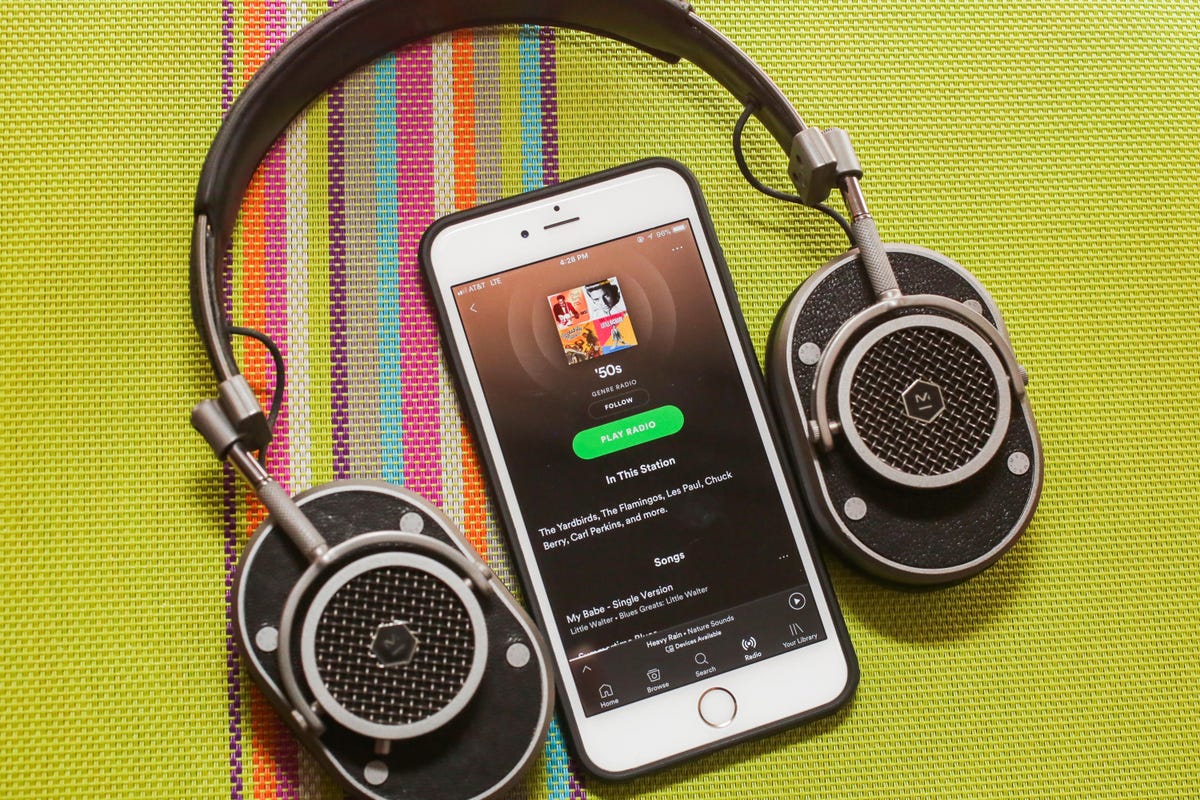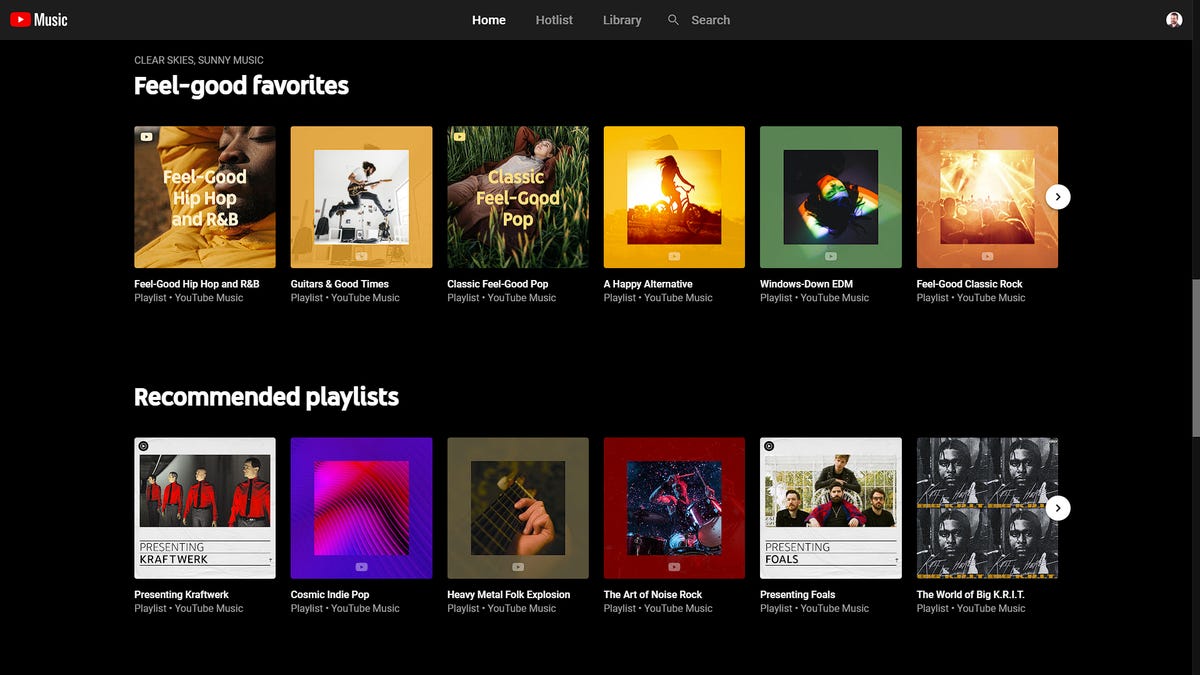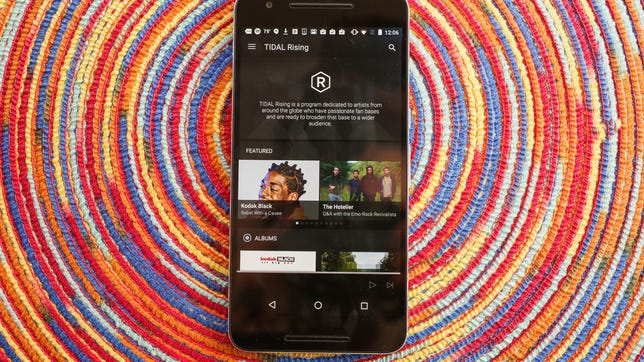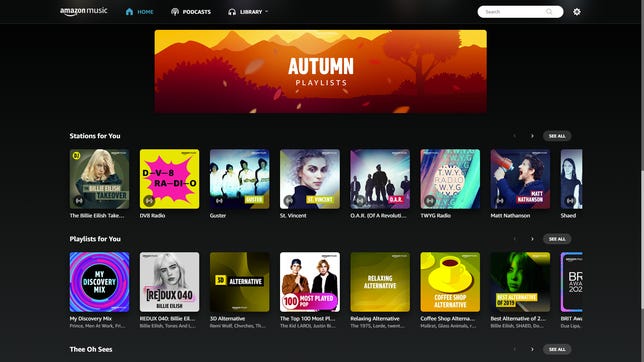Music streaming services offer users a world of convenience and discovery, allowing people to listen to their favorite artists easily and quickly. In the past, some audiophiles may have scoffed at the quality of streamed music, but a growing number of providers include lossless and spatial Dolby Atmos audio at no extra charge. Besides that, there are numerous extra features, such as karaoke, classical music, podcasts and audiobooks, vying for your attention.
If you’re shopping around, the main two things you need to consider are monthly cost and connectivity. Most of the services have music catalogs with around 100 million tracks, plus they enable you to stream from multiple devices. Until recently, prices had been stable at around $10 a month, but both Apple Music and Amazon Music Unlimited have increased their prices by a dollar.


I’ve checked out the biggest names, including Spotify, Apple Music, Amazon Music
and YouTube Music, as well as smaller contenders such as Tidal, Qobuz, Deezer and Pandora Premium, to see how each platform stacks up for your subscription buck. It’s worth noting that, in this roundup, I’ve purposefully left out services that can only play music in a radio format (such as basic Pandora and UnRadio) and that don’t allow you to select your own songs.
So which music streaming services offer the best combination of price, sound quality and library size? Read on to find an in-depth look at each of the services and a feature comparison, along with a full price breakdown in the chart at the bottom of the page. We’ll update this list periodically.
And if you want the TL;DR, these are the top three.
Read more: Apple Music vs. Spotify: Comparing the Top Music Streaming Services
Spotify is a pioneer in music streaming and is arguably the best-known service. It offers a number of curated music discovery services, including its Discover Weekly playlist, and is constantly implementing new ones, such as Stations and an AI DJ. The service has also ramped up its nonmusic content with a push toward podcasts, which indirectly led to folk-rock icon Neil Young removing his music from the service.
When it comes to choosing a service, it’s a close race between Spotify Premium and Apple Music, but Spotify still wins as the best music streaming service overall. This is thanks to a fun, easy-to-use interface, an extensive catalog and the best device compatibility. Spotify also offers the best free tier: Without paying a dime or providing a credit card number, you can listen to millions of tunes and even stream Spotify Connect to numerous Wi-Fi devices.
Unlike Spotify, competitors like Apple Music, Amazon Music Unlimited and Tidal are now offering lossless or even Dolby Atmos music at no extra charge. Meanwhile, Spotify’s planned HiFi (lossless) tier is still MIA and the company can’t say when it will be coming. In addition, the company hiked prices on a number of plans in 2021, even though the base price remains $10 a month in the US.
We like
- Free version is impressively robust
- Spotify Connect simplifies connecting to wireless speakers and AV receivers
- Easy to build your own playlists and sync them for offline listening
- Allows you to follow artists and be alerted when they release new music or announce an upcoming show
- Now includes podcasts
We don’t like
- Advertisements in the free service can be intrusive
- You can’t listen to specific songs in the free tier, just a mix based on the requested music
- No lossless option
- Podcasts have begun to overshadow music in importance
Best for: People who want a solid all-around service, and especially for people who love to make, browse and share playlists for any scenario.
Despite a small price increase in 2022, Apple Music is still able to offer a lot for the money, including 100 million tracks and boasting both iOS and Androidcompatibility. The service runs second to Spotify in terms of subscribers, but surpasses its rival in one key respect. Yes, it has hi-res lossless, spatial audio albums, plus a new classical music app at no extra charge.
While it makes the most sense if you’re an Apple user, Music is an option if you’ve invested heavily in smart speakers, including those from Google. If you own an Apple HomePod, Mini or Nest device you can summon Apple Music tracks with your voice. There are also a ton of curated playlists, many handcrafted by musicians and tastemakers, though it lacks the robust sharing options (or some of the cool add-ons) available to Spotify.
Until recently, PC users have been in the dark as far as Apple Music is concerned as they lacked a dedicated app. However, this has changed with the release of a “preview” Music app for Windows 11, giving PC fans a peek at what has been up to now a Mac-only experience.
If you like to buy your own digital music, Apple Music is the only one of our top three with a digital locker to store your own library of songs — YouTube Music, below, is the other music locker option.
We like
- Spatial and hi-res music included for your $11 a month
- Combines your iTunes library with music you don’t own, with a choice of music lockers
- Human music experts and algorithms help find music you’ll want to hear based on what you play
- You can control what you hear or search for new music using Siri on Apple HomePod or other Apple devices
We don’t like
- The experience isn’t quite as fun for Android or PC users
Best for: Those who are wrapped up in the Apple world, or who simply want excellent value for money.
Qobuz offers hi-res audio streams too, and unlike Tidal you don’t need a hardware MQA decoder to listen to them. They can sound great on an Android phone or a high-end music system, so it’s flexible. Qobuz may not offer Dolby Atmos music, but the selection of ‘immersive’ songs on other services isn’t that impressive anyway.
The service offers two plans — the hi-res Studio Premier ($13 monthly or $130 yearly) and the $180 annual Sublime Plus. Uniquely, the service offers its own hi-res download store, and if you sign up for Sublime you get a discount on purchases.
At 70 million tracks, Qobuz’s streaming catalog rivals Tidal’s and Spotify’s in number, though it may not have the most obscure artists. Qobuz generally steers towards hi-res recordings so it is especially suited to jazz and classical fans, though its rock selection is fairly robust. The fact that it’s cheaper than Tidal, and doesn’t require specialized equipment to listen in 24-bit/192Hz, makes Qobuz our favorite service for serious music lovers.
We like
- The app is really clean and fun to use
- Ability to listen to 24-bit music without needing a specialized decoder
- One of the more affordable hi-res services
- Offers a download store as well
We don’t like
- May be some gaps in the catalog
- No spatial audio
Best for: Audiophiles who want hi-res music for a decent price plus the ability to buy and download albums.
Top services compared
| Amazon Music Unlimited | Apple Music | Qobuz | Spotify | Tidal | YouTube Music | |
|---|---|---|---|---|---|---|
| Monthly fee | Prime members: $9, 9, N/A; Non-Prime members: $11, 11, AU$12; Echo-only service: Free, AU$6 | $11, 11, AU$13; Voice $5, 5, AU$6 | Studio: $13, 13, AU$20; Sublime (per year): $180, 180, AU$250 | $10, 10, AU$12 | Hi-Fi: $10, 10, AU$15; HiFi Plus: $20, 20, AU$24 | $10, 10, AU$12 |
| Free option? | Yes, with ads | No | No | Yes, with ads | Yes | Yes, with ads |
| Free trial period | 30 days | 3 months | 30 days | 30 days | 3 months | 30 days |
| Music library size | 100 million | 100 million | Over 90 million | Over 82 million | Over 80 million | Over 60 million |
| Maximum bit rate | 256Kbps, 3,730Kbps (HD) | 256Kbps, 1,152 Kbps (estimated) | 6,971Kbps | 320Kbps | 1,411Kbps | 256Kbps |
| Family plan? | Yes, $15, 15, AU$18 for max 6 | Yes, $15, 15, AU$18 for max 6 | Yes, $16.67, 16.67, AU$45 | Yes $16 per month, max 6 | Yes, 50% off each additional account, max 4 | Yes, $15, 15, AU$18 per month for max 6 |
| Student discount | No | Yes, Price varies by country | No | Yes, $5, 5 with Hulu and Showtime | Student HiFi: $5, Student HiFi plus: $10 (US only) | Yes, $5 |
| US military discount | No | No | No | No | Yes | No |
| Offline listening | Mobile and desktop | Mobile | Mobile and desktop | Mobile and desktop | Mobile | Premium, mobile only |
| Radio stations | Yes | Yes | No | Yes | No | Yes |
| Podcasts | Yes | No | No | Yes | Yes | Yes |
| Music videos | No | Yes | No | Yes | Yes | Yes |
| Music locker functionality | No | Yes | No | No | No | Yes |
Also worth considering
Now partly owned by Jack Dorsey’s Block, Tidal has introduced some important changes recently: namely that it now has a free tier called, naturally, Tidal Free. The company also offers the $10 Tidal HiFi plan, which includes lossless playback, and the premium $20 Tidal HiFi Plus tier.
Tidal HiFi Plus may be the most expensive of all the services, and while it offers hi-res and Dolby Atmos mixes, it recently had another good reason for this. Tidal’s main hook has always been that its higher subscription price translates to better payouts to artists — especially musicians who aren’t at the top of the pop charts. Yet sadly, the service will discontinue its Direct Artist Payouts (DAP) program — a scheme which paid your top streamed artist each month a 10% cut of your subscription fee — on April 1.
While Tidal used to be the best option for audiophiles, Qobuz has caught up by promising arguably better sound quality (no MQA decoder required), a cheaper price and some recent improvements in its catalog. Based on my own experience, Tidal still trumps it for breadth — and it now exceeds 80 million tracks, including longtime holdouts Metallica. If you’re an audiophile, a fan of urban music or a mix of both, then Tidal should appeal to you.
We like
- High-fidelity music streams including Dolby Atmos surround mixes
- Lots of video content, including concert livestreams
- Profiles and record reviews on every page, plus up-and-coming artist spotlights
- Free tier, while its top tier offers payouts for favorite artists
We don’t like
- The mobile apps and web player aren’t as straightforward as some others
- The catalog isn’t as exhaustive as Spotify Premium
- Most high-res music uses MQA, which needs a specialized decoder
Best for: Musically inclined purists who care deeply about sound quality and discovering new, up-and-coming artists.
Amazon Prime Music comes “free” as part of a Prime membership, but users can choose to upgrade to Music Unlimited. In addition to an expanded catalog, the step-up now includes theoriginal HD service at $9 for Prime members, or $11 if you don’t have Prime. Music Unlimited now gives you access to millions of lossless tracks as well as over 1,000 “spatial” remixes, which can be played on Dolby Atmos soundbars, Android or iOS devices and the Amazon Echo Studio. In terms of usability, the Music Unlimited interface is also more powerful than before with playlists, genres and podcasts all accessible from the main page.
We like
- Cheaper than the top three if you’re an Amazon Prime member
- Lyrics automatically pop up on the “now playing” screen
- Hi-res and spatial audio from Sony 360 Reality Audio and Dolby Atmos at no extra charge
- Offers free music stations for Amazon Echo, Echo Dot and Amazon Tap (includes ads)
We don’t like
- Artist profiles don’t have biographies
- The service no longer includes a music locker
Best for: Amazon Prime members who want to save a few bucks on a decent music catalog and higher-quality streams.
We also tested


-
YouTube Music: YouTube Music is the successor to Google Play Music
, and if you sign up for the ad-free YouTube Premium
at $12 per month, you get YouTube Music for free. The good news is that YouTube Music is a mostly impressive service (the lower bit-rate of 256kbps is mildly annoying), but Google has retained the predecessor’s music locker system enabling users to upload new tracks. In even better news, YouTube Music offers a cleaner interface than Google Play Music plus over 60 million tracks to choose from. Instead of playlists, YouTube Music offers well-curated radio stations that play endlessly and are updated often. The added ability to make playlists out of YouTube music clips also makes it a worthy option. See it at YouTube Music. - Deezer: French stalwart Deezer has been operating in the States since 2016, and it has a lot to offer, including a free tier (mobile only) and 90 million tracks. It has more subscribers than some others on this list, thanks in part to its previous affiliation with Cricket Wireless. The main Premium plan is $10 a month, but users are also able to upgrade to a lossless version (CD quality) for $15 a month. Deezer also offers a couple of unique features including being the first service enabling users to upload their catalogs from competitors at no extra charge. See it at Deezer.
- Pandora Premium: Still one of the most popular streaming radio services in the US, Pandora also offers the a la carte Premium ($10 a month)and no-ads Plus ($5 a month). The result is more flexibility than most competitors, and Premium has gained plenty more subscribers in recent years, even if the service is not keeping up in terms of overall catalog size. Sadly, its audio quality is among the lowest available, even on the Premium subscription (192Kbps), and it doesn’t really offer enough of an incentive for an upgrade from its highly popular free tier. See it at Pandora.
Music streaming FAQs
How do you transfer your library between services?
Without contracts it’s pretty easy to cancel one service and start with another. That said, swapping between music services isn’t as straightforward as swapping between movie locker services using Movies Anywhere for example. If you don’t want to have to rebuild your playlists and library from scratch when you switch, you have two main options — a music locker service such as YouTube Music (but this implies you have a library of ripped or bought MP3s), or an library import tool such as Soundiiz. The latter is a service that lets you import the songs from each of your music services and transfer them, and while there’s a $4.50 monthly charge, you can always cancel once you’ve converted your library. Recently, Deezer has offered the ability for new users to convert their libraries from other services for free (via another service called Tune My Music).
Do I need spatial or Atmos audio?
The short answer is “no” and the long answer is “sort of, maybe.” Stereo music has been around since the ’50s and the catalog dwarfs the handful of Atmos audio tracks by comparison. Apple may rave about how “magical” spatial music is, but unless you have an expensive Dolby Atmos system, you may not be able to hear the differences anyway.
In our own tests, we’ve found that a well-mixed Atmos track on a dedicated setup can be fun — it’s like a rollercoaster because it’s great but you wouldn’t want to use it as your sole form of transport. By comparison, using a pair of compatible AirPods we found the tracking to be laggy when attempting to move our heads around. On the other hand, spatial audio does make sense if you’re watching a movie as you’re not moving your head that much. The music industry tries unsuccessfully to push surround music every 20 years or so — Quadraphonic in the 1970s, DVD-Audio in the 2000s — but good old stereo will never go out of favor.
Which music streaming service has the biggest catalog?
At the time of writing, Apple Music and Amazon Music Unlimited have the largest catalogs with 100 million tracks each, followed by Spotify with 82 million. But that’s not the end of the story: The number of songs offered by a music service used to be the main differentiator, but as always, it’s quality over quantity that counts — and particularly if you’re looking for more obscure tracks. Depending on your favorite genre, some of the services may offer a better catalog for under-the-radar (Spotify), indie (Apple) or hip-hop artists (Tidal). Users who are less ambitious about expanding their musical taste should be satisfied with the catalogs that all the services offer.
Which services include music lockers?
Amazon was one of the first services to offer uploading your MP3 collection into the cloud, but this was officially discontinued in 2018. Meanwhile, both the Apple and YouTube services allow you to combine your personal music collection with the streaming catalog, though tagging and organization can be a time-consuming challenge (your myriad live Phish tracks won’t organize themselves). Still, if you’ve invested money in digital music over the years, those two services offer a patch to continue enjoying that music online.





